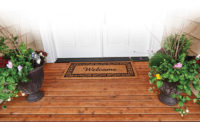
While efficient, such companies are not always successful in meeting the specified wants and needs of many clients.
The second school of thought in defining a successful residential installation company is one that specializes in custom security systems tailored to meet the particular needs of a handful of customers. Such companies may only do five to ten homes a year, but they are large projects. For these companies, security is just part of larger home automation projects.
Along with lighting control and home entertainment demands, the security system is a subsystem of the overall home automation project. Often such systems include cameras to monitor perimeter activity outside the house and internal activity in certain areas within the home. Along with selling piece of mind, such companies sell a lifestyle.
TAPPING TODAY’S TRENDS
In the past, homeowners emphasized protecting valuables within the home. Today, protecting one’s family is the top priority. The combination of broadband Internet access in the home along with a plethora of products designed to protect both home and family prompts this continuing trend. Installing security video cameras inside and outside the home emphasizes a trend that will continue for the foreseeable future.Dan Budinoff, president of Security Specialists in Greenwich, Conn., explains two thought processes commonly expressed by today’s homeowners in regard to video at home. First, while at home, the owner chooses to view outside activity on the TV. This is a great way for a mother to keep an eye on her children while they are playing outside, for example. The user wants to know what is happening in the pool, at the front door and on the driveway, but he does not care to record activity or view such activity from a remote location.
A second type of user chooses to install a few cameras outside and some inside the house as well. The user remotely views the nanny while at the office, or can sneak a peek at his children while they are napping. He can also see who rang the doorbell and what time the mail arrived. DVRs record events and the user may view it later and store it. This is an ideal solution for customers who travel frequently, yet want to maintain a level of control over their homes, for example.

SPECIFIC SALES APPROACH
Of course, video surveillance cameras are available in a variety of sizes, shapes, and protective exteriors, and cameras in the home can be expensive, depending on the user’s quality requirements.“The biggest drawback of people doing video in homes is when they find out what it costs – it’s expensive,†Budinoff says.
High quality cameras that record crisp, digital images without overwhelming file sizes can be relatively expensive. And file size is especially important when viewing video remotely. Digital files as small as 0.3 KB allow users to view real-time streaming video, and more images can be stored at that size.
More affordable camera options often have poorer picture quality and require larger file sizes. Large, cumbersome files cannot be viewed easily from a remote location, and fewer images can be stored.
Along with his knowledge of integrated home systems and in-house video, key to the success of Andrew Wiatrak, president of Sensation AV, Plymouth, Minn., is his ability to explain home automation, security and entertainment functions to customers. Since he is selling a lifestyle, his customers don’t care what the “black box is and how it performs.†They care about what it can do for them. “I help them fit it in with their lives,†Wiatrak says.
Sidebar: Secrets to Success
Why are the top dealers so successful? They sell solutions with their knowledge, scope and experience. This simple formula is particularly true for integrated solutions, especially in-house video surveillance systems.
Know your market
“Know your market, and don’t sell something to someone just because they want it,†says Dan Budinoff, president of Security
Specialists, Greenwich, Conn. “Educate the customer and ask why they want a camera in a certain location. Work with them to make the appropriate solution.â€
“Have the knowledge to integrate systems together,†says Andrew Wiatrak, president of Sensation AV, Plymouth, Minn. “We understand exactly how video, audio and security work, and can take subsystems and integrate them into a large control system to make it easy to operate.†Integration and ease of operation are staples of in-house systems, and such features will essentially sell themselves.
Finish your project
“A finished project equals success,†says David Teel, co-founder of Avenida Network, Richardson, Texas. “It doesn’t matter how complex, how large or how intricate the system; if you can’t finish the job, you will never be successful.â€
Understanding the complexities of a project and simplifying it for the customer is another key to success.
Sell your expertise
“Become experts; expertise sells,†Teel says. “Build your technical team to be the strongest in your market; if you have any technical weaknesses, then either hire the appropriate technical expertise or outsource. Then bottle that expertise and sell it to your marketplace. Good news spreads fast.â€



